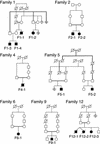Clinical and molecular analysis of patients with defects in micro heavy chain gene
- PMID: 12370281
- PMCID: PMC151150
- DOI: 10.1172/JCI15658
Clinical and molecular analysis of patients with defects in micro heavy chain gene
Abstract
Autosomal recessive disorders of B cell development are rare and heterogeneous. To determine the proportion of affected patients who have defects in the micro heavy chain (IGHM) gene, we used single-stranded conformational polymorphism analysis to screen genomic DNA from 40 unrelated patients with early onset infections, profound hypogammaglobulinemia, and absent B cells. All of the patients were genotypically normal in BTK, the gene that underlies X-linked agammaglobulinemia. Eight different mutations in the micro heavy chain were identified in 19 members of 12 unrelated families. Four of the mutations were large deletions that removed more than 40 kb of DNA in the IGHM locus. In six of the 12 families, the affected patients had an identical single base pair substitution, a G-->A, at the -1 position of the alternative splice site. Immunoglobulin haplotype analysis showed that this mutation occurred on at least three different haplotypes, indicating that this is a hot spot for mutations. Compared with patients with mutations in Btk, patients with defects in the micro heavy chain had an earlier onset of disease and more complications. Our study indicates that at least 20-30% of patients with autosomal recessive defects in B cell development have mutations in the micro heavy chain.
Figures


Similar articles
-
Mutations in the mu heavy-chain gene in patients with agammaglobulinemia.N Engl J Med. 1996 Nov 14;335(20):1486-93. doi: 10.1056/NEJM199611143352003. N Engl J Med. 1996. PMID: 8890099
-
Molecular analysis of the pre-BCR complex in a large cohort of patients affected by autosomal-recessive agammaglobulinemia.Genes Immun. 2007 Jun;8(4):325-33. doi: 10.1038/sj.gene.6364391. Epub 2007 Apr 5. Genes Immun. 2007. PMID: 17410177
-
Autosomal recessive agammaglobulinemia due to defect in μ heavy chain caused by a novel mutation in the IGHM gene.Genes Immun. 2017 Sep;18(3):197-199. doi: 10.1038/gene.2017.14. Epub 2017 Aug 3. Genes Immun. 2017. PMID: 28769069
-
Genetic analysis of patients with defects in early B-cell development.Immunol Rev. 2005 Feb;203:216-34. doi: 10.1111/j.0105-2896.2005.00233.x. Immunol Rev. 2005. PMID: 15661032 Review.
-
[Agammaglobulinemia as early B cell defects].Nihon Rinsho Meneki Gakkai Kaishi. 2000 Oct;23(5):435-44. Nihon Rinsho Meneki Gakkai Kaishi. 2000. PMID: 11155713 Review. Japanese. No abstract available.
Cited by
-
Peripheral B Cell Deficiency and Predisposition to Viral Infections: The Paradigm of Immune Deficiencies.Front Immunol. 2021 Aug 30;12:731643. doi: 10.3389/fimmu.2021.731643. eCollection 2021. Front Immunol. 2021. PMID: 34527001 Free PMC article. Review.
-
Autosomal recessive agammaglobulinemia: novel insights from mutations in Ig-beta.Curr Allergy Asthma Rep. 2008 Sep;8(5):404-8. doi: 10.1007/s11882-008-0078-7. Curr Allergy Asthma Rep. 2008. PMID: 18682105 Review.
-
Pre-B cell receptor signaling in acute lymphoblastic leukemia.Cell Cycle. 2009 Dec;8(23):3874-7. doi: 10.4161/cc.8.23.10035. Epub 2009 Dec 9. Cell Cycle. 2009. PMID: 19901533 Free PMC article.
-
Agammaglobulinemia associated with BCR⁻ B cells and enhanced expression of CD19.Blood. 2011 Aug 18;118(7):1828-37. doi: 10.1182/blood-2011-01-330472. Epub 2011 Jun 21. Blood. 2011. PMID: 21693761 Free PMC article.
-
Immunity to microbes: lessons from primary immunodeficiencies.Infect Immun. 2007 Apr;75(4):1545-55. doi: 10.1128/IAI.00787-06. Epub 2007 Feb 5. Infect Immun. 2007. PMID: 17283094 Free PMC article. Review. No abstract available.
References
-
- Yel L, et al. Mutations in the mu heavy chain gene in patients with agammaglobulinemia. N Engl J Med. 1996;335:1486–1493. - PubMed
-
- Matsuda F, et al. Structure and physical map of 64 variable segments in the 3′ 0.8- megabase region of the human immunoglobulin heavy-chain locus. Nat Genet. 1993;3:88–94. - PubMed
-
- Cook GP, et al. A map of the human immunoglobulin VH locus completed by analysis of the telomeric region of chromosome 14q. Nat Genet. 1994;7:162–168. - PubMed
Publication types
MeSH terms
Substances
Grants and funding
LinkOut - more resources
Full Text Sources
Molecular Biology Databases
Miscellaneous

